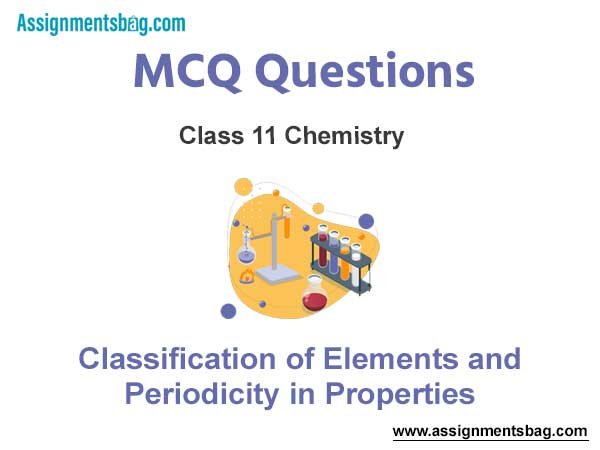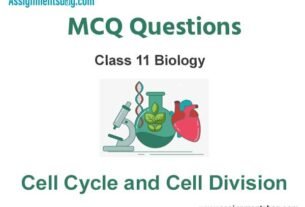Please refer to MCQ Questions Chapter 3 Classification of Elements and Periodicity in Properties Class 11 Chemistry with answers provided below. These multiple-choice questions have been developed based on the latest NCERT book for class 11 Chemistry issued for the current academic year. We have provided MCQ Questions for Class 11 Chemistry for all chapters on our website. Students should learn the objective based questions for Chapter 3 Classification of Elements and Periodicity in Properties in Class 11 Chemistry provided below to get more marks in exams.
Chapter 3 Classification of Elements and Periodicity in Properties MCQ Questions
Please refer to the following Chapter 3 Classification of Elements and Periodicity in Properties MCQ Questions Class 11 Chemistry with solutions for all important topics in the chapter.
MCQ Questions Answers for Chapter 3 Classification of Elements and Periodicity in Properties Class 11 Chemistry
Question. Which of the following statements is wrong?
(a) Metals are more than non-metals
(b) There are only few metalloids
(c) Hydrogen can be placed with alkali metals as well as with halogen in periodic Table
(d) Non-metals are more than metals
Answer
D
Question. The correct order of decreasing first ionisation energy is
(a) C > B > Be > Li
(b) C > Be > B > Li
(c) B > C > Be > Li
(d) Be > Li > B > C
Answer
B
Question. The property of attracting electrons by the halogen atoms in a molecuJe is caJled
(a) ionisation potential
(b) e lectron affinity
(c) electronegativity
(d) electronic attraction
Answer
C
Question. Which of the following electronic configuration represents noble gas?
(a) ns2np6
(b) ns2np5
(c) ns2np4
(d) ns2np3
Answer
A
Question. The element with the lowest ionisation potential is
(a) Na
(b) K
(c) Rb
(d) Cs
Answer
D
Question. Highest electron affinity among the following is
(a) fluorine
(b) chlorine
(c) sulphur
(d) xenon
Answer
B
Question. The electronic configuration, Is2 , 2s2 2p6 , 3s2 3p6 3d9 represents a
(a) metal atom
(b) non-metal atom
(c) non-metallic anion
(d) metallic cation
Answer
D
Question. Which of the following has largest ionic radius?
(a) Cs+
(b) Li+
(c) Na+
(d) K+
Answer
A
Question. Among Na+, Na, Mg and Mg2+, the largest particle is
(a) Mg2+
(b) Mg
(c) Na
(d) Na+
Answer
C
Question. The first ionisation potential is maximum for
(a) B
(b) N
(c) O
(d) Be
Answer
B
Question. The first ionisation energy of oxygen is less than that of nitrogen. Which of the following is the correct reason for this observation?
(a) Lesser effective nuclear charge of oxygen than nitrogen
(b) Lesser atomic size of oxygen than nitrogen
(c) Greater interelectron repulsion between two electrons in the same p-orbital counter balances the increase in effective nuclear charge on moving from nitrogen to oxygen
(d) Greater effective nuclear charge of oxygen than nitrogen
Answer
C
Question. In a given shell the order of screening effect is
(a) s>p>d>f
(b) s>p>f>d
(c) f>d>p>s
(d) s<p<d<f
Answer
A
Question. Which of the following oxides doesn’t react with both of an acid and alkali, is?
(a) ZnO
(b) SnO2
(c) Al2O3
(d) BeO
Answer
D
Question. Ionic radius is
(a) inversely proportional to effective nuclear charge
(b) inversely proportional to square of effective nuclear charge
(c) directly proportional to effective nuclear charge
(d) directly proportional to square of effective nuclear charge
Answer
A
Question. The correct order of electronegativity ofN, 0 , F and P is
(a) F > N > P > 0
(c) F > O > N > P
(b) F > O > P > N
(d) N > O > F > P
Answer
C
Question. Which of the following sets has the atoms and/or ions in the correct order of increasing size?
(a) Ne < F– < 02-
(b) Br– < C1- < F–
(c) Na+ < Mg2+ < Al3+
(d) P < S < Cl
Answer
A
Question. In the periodic table metals usually used as catalyst belong to
(a) f -block
(b) d-block
(c) p-block
(d) s-block
Answer
B
Question. The order of stability of metal oxides is
(a) Al2O3 < MgO < Fe2O3 < Cr2O3
(b) Cr2O3 < MgO < Al2O3 < Fe2O3
(c) Fe2O3 < Cr2O3 < Al2O3 < MgO
(d) Fe2O3 < Al2O3 < Cr2O3 < MgO
Answer
C
Question. The pair of elements ionisation potential is having approximately equal
(a) Al,Ga
(b) Al, Si
(c) Al, Mg
(d) Al, B
Answer
A
Question. The element with the electronic configuration as [Ar]3d10 4s24p3 represents a
(a) metal
(b) non-metal
(c) metalloid
(d) transition element
Answer
C
Question. The elements present in the core of earth are collectively known as
(a) lithophiles
(b) nucleophiles
(c) chalcophiles
(d) siderophiles
(e) atmophiles
Answer
D
Question. Which one of the following orders presents the correct sequence of the increasing basic nature of the given ox.ides?
(a) Al2O3 < MgO < Na2O < K2O
(b) MgO < K2O < Al2O3 < Na2O
(c) Na2O < K2O < MgO < Al2O3
(d) K2O < Na2O < Al2O3 < MgO
Answer
A
Question. The number of naturally occurring p-block elements that are diamagnetic are
(a) 18
(b) 6
(c) 5
(d) 7
Answer
C
Question. Among the following, the number of elements showing only one non-zero oxidation state is O , Cl, F, N, P, Sn, Tl, Na, Ti
(a) l
(b) 2
(c) 3
(d) 4
Answer
B
Question. Which of the following element is metalloid?
(a) Bi
(b) Sn
(c) Ge
(d) C
Answer
C
Question. The element having highest electron affinity is
(a) bromine
(b) iodine
(c) fluorine
(d) chlorine
Answer
D
Question. The elements with atomic numbers 9, 17, 35, 53, 85 are all
(a) noble gases
(b) halogens
(c) heavy metals
(d) light metals
Answer
B
Question. Which of the following is not a pe1iodic property?
(a) Atomic mass
(b) Atomic volume
(c) Covalent radius
(d) Electronegativity
Answer
A
Question. Which one of the following ions has the highest value of ionic radius ?
(a) Li+
(b) B3+
(c) O2-
(d) F–
Answer
C
Question. The correct order of size of iodine species is
(a) I > I– > I+
(b) I– > I > I+
(c) I+ > I > I–
(d) I– > I+ > I
Answer
B
Question. The strongest base of the following is
(a) NaOH
(b) KOH
(c) LiOH
(d) CsOH
Answer
D
Question. What is the name of element with atomic number 105?
(a) Kurchatovium
(b) Dubnium
(c) Nobelium
(d) Holmium
Answer
B
Question. Differentiating electron in inner transition elements enters the …… orbital.
(a) s
(b) p
(c) d
(d) f
Answer
D
Question. Order of electron affinity of F, Cl, Br and I is
(a) F < Cl > Br > I
(b) F > Cl > Br > I
(c) F < Cl < Br < I
(d) F > Cl < Br > I
Answer
A
Question. The increasing order of the ionic radius of the given isoelectronic species is
(a) Cl– < Ca2+ < K+ < S2-
(b) S2-< Cl– < Ca2+ < K+
(c) Ca2+ < K+ < Cl– < S2-
(d) K+ < S2-– < Ca2+ < Cl–
Answer
C
Question. In which one of the following pairs the radius of the second species is greater than that of the first?
(a) Na, Mg
(b) O2- , N3-
(c) Li+ , Be2+
(d) Ba2+ ,Sr2+
Answer
B
Question. The ionisation potential order for which set is correct?
(a) Cs < Li < K
(b) Cs < Li > B
(c) Li > K > Cs
(d) B > Li < K
Answer
C
Question. One mole of magnesium in the vapour state absorbed 1200 kJmo1- 1 of energy. If the first and second ionisation energies of Mg are 750 and 1450 kJmol – 1 respectively, the final composition of the mixture is
(a) 31% Mg+ + 69% Mg2+
(b) 69% Mg+ + 31% Mg2+
(c) 86% Mg+ + 14% Mg2+
(d) 14% Mg+ + 86% Mg2+
Answer
B
Question. Which of the following elements never show positive oxidation number?
(a) O
(b) Fe
(c) Ga
(d) F
Answer
D
Question. Which element has highest electronegativity?
(a) F
(b) He
(c) Ne
(d) Na
Answer
A
Question. Which among the following elements have lowest value of IE1 ?
(a) Pb
(b) Sn
(c) Si
(d) C
Answer
B
Question. Which of the following metal oxides is most basic?
(a) ZnO
(b) Al2O3
(c) As2O3
(d) K2O
Answer
D
Question. Difference between S and S2- as S2- has
(a) larger radii and larger size
(b) smaller radii and larger size
(c) larger radii and smaller size
(d) smaller radii and smaller size
Answer
A
Question. The successive ionisation energy values for an element X are given below.
I. 1st ionisation energy = 410 kJ mol-1
II. 2nd ionisation energy = 820 kJ mol-1
III. 3rd ionisation energy = 1100 kJ mol-1
IV. 4th ionisation energy= 1500 kJ mol-1
V. 5th ionisation energy= 3200 kJ mol-1
Find out the number of valence electron for the atom X .
(a) 4
(d) 2
(c) 5
(b) 3
Answer
A
Question. Strongest oxidising agent among halogen is
(a) I2
(b) Br2
(c) Cl2
(d) F2
Answer
D
Question. Atomic radii ofF and Ne, in A, are given by
(a) 0.72, 0.71
(b) 0.72, 1 .6
(c) 1.6, 1.58
(d) 0.71, 0.72
Answer
B
Question. Which of the following element shows maximum valency?
(a) Carbon
(b) Barium
(c) Nitrogen
(d) Sulphur
Answer
D
Question. Which one of the following oxides is an1photetic in character?
(a) SnO2
(b) SiO2
(c) CO2
(d) CaO
Answer
A
Question. In which of the following arrangements the order is not according to the property indicated against it?
(a) Li < Na < K < Rb increasing metallic radit1s
(b) I < Br< F < Cl increasing electron gain enthaly (with negative sign)
(c) B < C < N < O increasing first ionisation enthalphy
(d) Al3+ < Mg2+ < Na+ < F– increasing ionic size
Answer
C
Question. Electron affinity is positive, when
(a) Ochanges into O–
(b) O- changes into O2-
(c) O changes into O+
(d) electron affinity is always negative
Answer
B
Question. Ionisation potential for a noble gas is
(a) maximum in a period
(b) minimum in a period
(c) either minimum or maximum
(d) constant
Answer
A
Question. The order of first ionisation energies of the elements Li, Be, B, Na is
(a) Li > Be > B > Na
(b) Be > B > Li > Na
(c) Na > Li > B > Be
(d) Be > Li > B > Na
Answer
B
Question. Which is the correct order of electronegativity?
(a) F > N < O > C
(b) F > N > O > C
(c) F > N > O < C
(d) F < N < O = C
Answer
A

We hope you liked the above provided MCQ Questions Chapter 3 Classification of Elements and Periodicity in Properties Class 11 Chemistry with solutions. If you have any questions please ask us in the comments box below.


